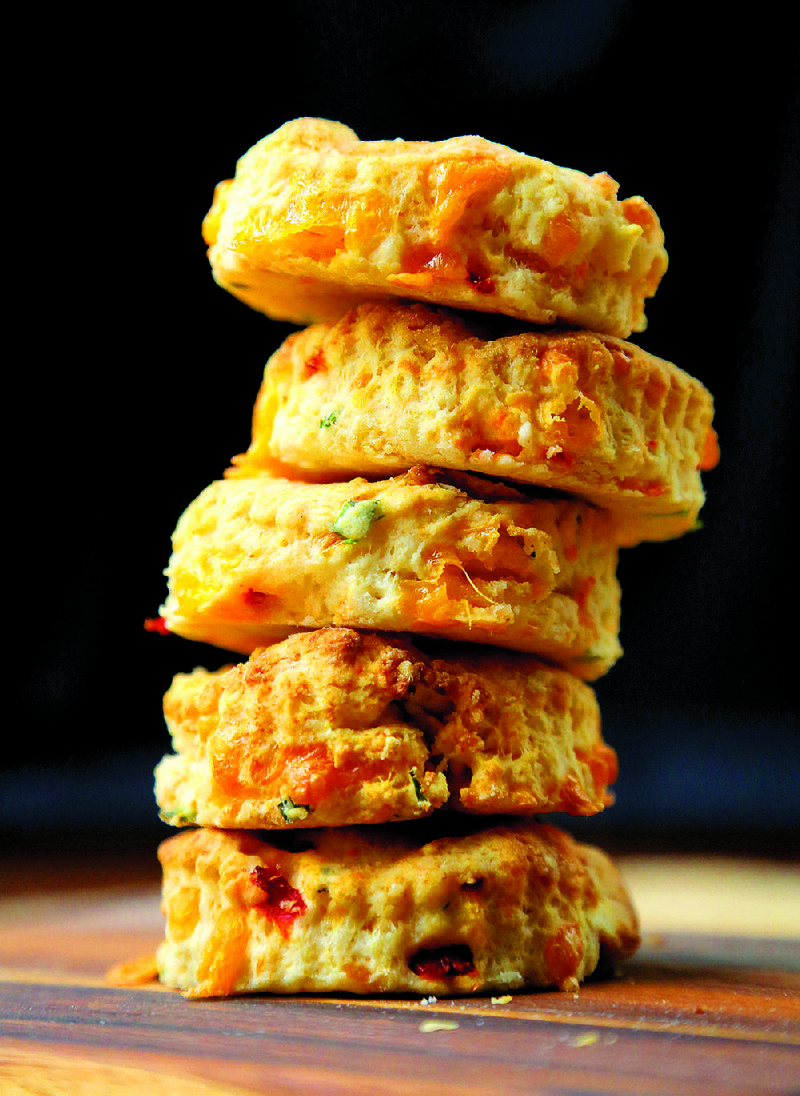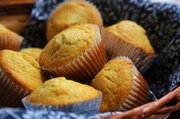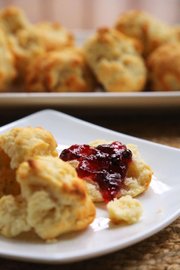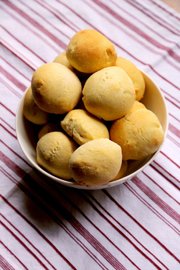Biscuits and cornbread. Or perhaps, if you have plenty of time, rolls.
These small (either because they are formed as or cut into individual portions) breads make almost any meal complete. From breakfast to dinner, from cradling gravy to sopping up potlikker, not only are they filling, but small breads help us make use of every tasty bite.
There was a time when these breads would have been made from scratch for every meal. But today, most of us are much more likely to turn to Sister Schubert, Pillsbury or Rhodes.
It doesn't have to be that way.
Not only are from-scratch biscuits, rolls and cornbread often superior in flavor and texture to ready-made or boxed mixes, they're free of preservatives and artificial ingredients too.
Good bread (or biscuits) starts with the right flour. And the "right" flour has very much to do with the protein content of the wheat. (Gluten-free baking is an entirely different animal and won't be covered here. Sorry.)
The tricky part is knowing exactly how much protein is in each type of flour. Most packages don't include protein percentages.
For biscuits, cakes and other tender breads, lower protein flour made from soft wheat is preferred. In other words, don't use bread flour to make biscuits. Lower-protein flour includes cake flour, pastry flour and some all-purpose flours.
All-purpose flour's protein content varies by region. Here in the South (and in the Pacific Northwest), all-purpose flour is lower in protein than that found in Canada and other parts of the United States. In general all-purpose flour has between 10 percent and 12 percent protein.
Bread flour, on the other hand, is milled from hard wheat and has at least 12 percent protein. Yeast doughs made with bread flour are stretchier, more elastic and rise higher. The resulting bread is chewier and has a more developed flavor.
Self-rising flour has gotten a bad rap. Contrary to what you may have heard, it is perfectly acceptable to use in any unyeasted bread recipe. Simply adjust the salt and leavening accordingly. In fact, because self-rising flour is made almost exclusively from soft wheat, it is lower in protein than non-Southern all-purpose flour.
A general guide to protein content in flours:
• Cake and pastry flour: seven to nine percent.
• All-purpose flour: 10 percent to 12 percent.
• Bread flour: 12 percent to 16 percent.
Sources: White Lily Flour, King Arthur Flour, The Science of Good Food by David Joachim and Andrew Schloss
There are two basic biscuit types: drop and rolled. Drop biscuits are made from a wet, batter-like dough. Cut biscuits are made from a dough
that is patted or rolled, then cut. Regardless of what kind you make, work the dough as little as possible and use a low-protein flour.
Cream Biscuits
2 cups self-rising flour
1 tablespoon granulated sugar
1 1/2 cups heavy cream
Heat oven to 450 degrees. Generously grease or line a baking sheet with parchment paper.
In a large bowl, mix flour and sugar. Pour in cream and stir until flour is wet. Using your fingers or a small scoop, break off or scoop dough and drop 2 inches apart onto the prepared baking sheet.
Bake 12 to 15 minutes or until golden brown.
Makes about 12 biscuits.
Recipe adapted from Biscuits: Sweet and Savory Southern Recipes for the All-American Kitchen by Jackie Garvin
These savory biscuits are the next best thing to pimento cheese.
Pimento Cheese Biscuits
2 cups all-purpose flour OR cake flour, plus more for dusting
2 teaspoons granulated sugar
4 teaspoons baking powder
1/2 teaspoon salt
1/2 teaspoon cream of tartar
1/2 cup shortening, chilled
2/3 cup shredded cheddar cheese
2 tablespoons minced fresh chives
2 tablespoons minced pimentos or roasted red bell pepper, patted dry
2/3 cup milk
2 tablespoons butter, melted
Pimento cheese (your favorite recipe), for serving, optional
Heat oven to 450 degrees.
In a large bowl, whisk together the flour, sugar, baking powder, salt and cream of tartar.
Using a pastry blender or your fingers, cut (or rub) in shortening until it is completely incorporated and the mixture resembles coarse meal. Add the cheese, chives and pimentos and stir with a spatula. Stir in the milk and mix until just combined. Be careful not to over mix.
Turn dough out onto a floured surface and knead 4 to 5 times, turning 90 degrees with each knead. Sprinkle flour over dough as necessary to keep it from sticking.
Pat dough to 3/4-inch thick. Using a sharp biscuit cutter, cut dough into 2-inch biscuits, using an up and down motion (do not twist cutter), dipping cutter into flour between each cut. Gather the scraps and gently press them together and cut as many biscuits as possible.
Arrange biscuits on a parchment-lined baking sheet. The biscuits should be close, but not touching. Bake 15 minutes or until browned on tops and bottoms, rotating pan halfway through.
Brush hot biscuits with melted butter. Serve filled with pimento cheese, if desired.
Makes 12 (2-inch) biscuits.
Recipe adapted from Southern Breads: Recipes, Stories and Traditions by Marilyn Markel and Chris Holaday
Despite their name, these soft rolls are nothing like cornbread. They are delicious hot from the oven slathered in butter, but also good warmed the next day. Cooked cornmeal gives the rolls body without adding a gritty texture.
Cornmeal Rolls
2 1/4 teaspoons active dry yeast
1/4 cup warm water
1/2 cup PLUS 1/4 teaspoon granulated sugar, divided use
2 cups milk
1/2 cup cornmeal
1/2 cup butter, cut into tablespoons
1/2 teaspoon salt (increase salt to 3/4 teaspoon if using unsalted butter)
2 eggs
4 1/2 to 6 cups all-purpose flour, plus more as needed
In a mixing bowl, combine the yeast, warm water and 1/4 teaspoon sugar; set aside.
Meanwhile, in a saucepan, combine the milk and cornmeal over medium heat. Whisking frequently, bring mixture to a boil and cook until thick and smooth, about 2 minutes.
Remove from heat and add the butter, 1/2 cup sugar and salt. Let mixture cool for about 10 minutes.
Beat eggs into yeast mixture; then whisk in cornmeal mixture. Add the flour and knead to form a dough. Dough will be soft and somewhat tacky. If it is very wet, work in more flour, 1 tablespoon at a time, to achieve desired consistency.
Let it rise until doubled, about 1 hour.
Heat oven to 350 degrees.
Turn dough out on to a lightly floured surface. Divide and shape dough into balls and arrange balls, spaced 2 inches apart, on a parchment-lined baking sheet. Bake rolls 20 minutes or until browned on top.
Makes about 2 dozen small rolls.
Recipe adapted from lemonmarinnpie.com
These are not rolls to make on the spur of the moment, but the investment in time is worth it. Plan to start this recipe 24 to 48 hours before you plan to serve the rolls.
Pull-Apart Butter-Top Rolls
3 2/3 cups bread flour PLUS more as needed, divided use
2 1/4 tablespoons granulated sugar
1/4 teaspoons salt
1 teaspoon active dry yeast OR 3/4 teaspoon instant, fast-rising yeast
1 3/4 cups very cold water, plus more as needed
5 tablespoons butter, melted and cooled, divided use, PLUS more for coating
1/4 cup instant nonfat dry milk
1 egg, beaten
In a large bowl stir together 3 cups of the flour, the sugar, salt and yeast. Add water and stir until completely combined, scraping sides of bowl as necessary. If mixture is too dry to incorporate all of the flour, add water a drop or two at a time, until mixture comes together. Brush top of dough with melted butter. Cover and refrigerate 3 to 10 hours, then let rise at room temperature for 16 to 24 hours more, vigorously stirring dough after 8 to 12 hours.
In a medium bowl, stir together 3 tablespoons of the melted butter, the dry milk and egg. Vigorously stir (or mix in a stand mixer fitted with the dough hook) the butter mixture into the dough until smooth. Gradually add the remaining 2/3 cup flour. Using a well-oiled rubber spatula, fold the dough in toward the center, working all the way around the bowl.
Coat a 9-by-13-inch baking dish with melted butter or nonstick spray. Generously dust a large sheet of parchment paper with flour. Generously dust a large (at least 14 inches) cutting board with flour.
Generously dust the dough with flour, working the flour into the dough until it is less sticky and easier to handle. Turn the dough out on to the floured board. Cut it into three equal portions. Leave one portion on the cutting board; place the remaining portions, cut-side down, on the parchment, leaving plenty of space between portions.
Working on the cutting board, press and pat one portion of the dough into a 5-by-10-inch rectangle, dusting the dough and board with flour as needed to prevent sticking. If the dough is resistant or springy, let it rest for a few minutes, then continue.
Tightly roll the rectangle to form a 10-inch log. Pinch the seam tightly closed. Dust with more flour, then turn log seam-side down. Working from the middle, stretch the dough to form a 12-inch log that is evenly thick, then flatten to about 21/2-inches wide.
Cut into 8 to 12 slices. Transfer cut dough to the baking dish, placing the row lengthwise in the pan so that it fills one 13-inch side, pulling the rolls apart slightly.
Repeat with remaining dough. Arranging the rolls so that they cover the pan, with gaps between each roll. The rolls will come together to fill the pan and the gaps as they rise and bake. Brush the tops with 1 tablespoon of the melted butter. Tent pan with nonstick foil (or foil coated in nonstick spray) and let rise at room temperature for 11/2 to 21/2 hours or refrigerate and let rise for 4 to 48 hours. (If letting rolls rise in the refrigerator, finish rising at room temperature.) Let rolls rise until they are doubled their original size, removing the foil if the dough nears it.
Heat oven to 350 degrees.
Bake rolls 20 to 25 minutes or until tops are browned, then cover with foil and bake 3 to 5 minutes more. Rolls are done when they reach an internal temperature of 206 degrees or a tester inserted near the center to the bottom comes out clean.
Brush the rolls with the remaining tablespoon of butter. Cool on a wire rack for 10 minutes, then lift rolls from pan and serve immediately.
The baked rolls will keep at room temperature for 2 to 3 days, or frozen in an airtight container for up to 2 months. To reheat, wrap rolls in foil and heat in a 350-degree oven.
Makes 24 to 36 rolls.
Recipe adapted from Kneadlessly Simple: Fabulous, Fuss-Free, No-Knead Breads by Nancy Baggett
These sweet cornbread muffins are delicious paired with spicy barbecue, slathered with butter for breakfast or enjoyed as dessert. (Sweet cornbread haters, please, keep your comments to yourself. I believe all cornbread deserves a place at the table. Sweet, savory, cheesy, spicy. I love all cornbread.)
Honey Corn Muffins
1 cup yellow cornmeal
1 cup all-purpose flour
1 tablespoon baking powder
1/2 cup granulated sugar
1 teaspoon salt
1 cup whole milk
2 eggs
1/4 cup butter, melted
1/4 cup honey
Heat oven to 400 degrees. Line 12 muffin cups with paper liners.
Into a large bowl, mix the cornmeal, flour, baking powder, sugar and salt.
In a separate bowl, whisk together the milk, eggs, butter and honey. Add the wet to the dry ingredients and stir until just moistened.
Spoon batter into muffin cups, dividing evenly. Bake 15 minutes or until golden brown.
Makes 1 dozen.
Recipe adapted from Patrick and Gina Neely via Food Network
Food on 01/25/2017



